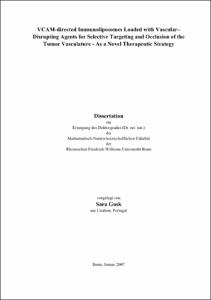Online-Ausgabe in bonndoc: https://nbn-resolving.org/urn:nbn:de:hbz:5N-14475
urn: https://nbn-resolving.org/urn:nbn:de:hbz:5N-14475,
author = {{Sara Gosk}},
title = {VCAM-directed Immunoliposomes Loaded with Vascular– Disrupting Agents for Selective Targeting and Occlusion of the Tumor Vasculature : As a Novel Therapeutic Strategy},
school = {Rheinische Friedrich-Wilhelms-Universität Bonn},
year = 2008,
note = {
Targeting the tumor vasculature and selectively modifying endothelial functions with agents that exert their action on the tumor endothelial cells instead of the tumor cells themselves, is an attractive anti-tumor strategy. Polyethylenglycol modified immunoliposomes (IL) directed against vascular cell adhesion molecule 1 (VCAM), a surface receptor over-expressed on tumor vessels, were prepared and investigated the liposomal targetability in vitro and in vivo. The vascular destructing agents, tumor necrosis factor alpha (TNF-α) and the TNF-α inducing drug, DMXAA, are known to selectively target the tumor endothelium and induce a pro-coagulative state, which leads to a collapse of the tumor vasculature. The hypothesis that TNF-α and DMXAA modulate the coagulative state of the endothelium through the up-regulation of tissue factor (TF) was investigated in vitro. VCAM-targeted and non-targeted liposomes loaded with either TNF-α or DMXAA were formulated and upon administration tumor growth delay was investigated in vivo. In vitro, VCAM antibodies conjugated to PEGylated liposomes through the cyanur anchor displayed specific binding to activated endothelial cells under static conditions, as well as under simulated blood flow conditions. The in vivo targeting of IL was analyzed in mice bearing human Colo 677 tumor xenografts 30 min and 24 h post i.v. injection. Whereas biodistribution studies using [3H]-labeled liposomes displayed only marginal higher tumor accumulation of VCAM targeted vs. unspecific ILs; fluorescence microscopy evaluation revealed that their localization within tumors differed strongly. VCAM targeted ILs accumulated in tumor vessels with increasing intensities from 30 min to 24 h, while control ILs accumulated in the tumor tissue by passive diffusion.
TNF-α and DMXAA displayed a direct cytotoxic effect on the murine endothelial cells, and induced an 3-fold up-regulation of TF expression and activity after 6 and 12 hours in vitro. TNF-α and DMXAA were encapsulated into PEGylated liposomes with reasonable encapsulation efficiencies of 33 % and 18 %, respectively. Treatment of mice bearing human Colo 677 xenografts with VCAM-targeted liposomes loaded with TNF-α or DMXAA delayed the tumor growth compared to mice treated with non-targeted TNF-α liposomes and non-treated mice. The mechanism behind the tumor growth delay was investigated using TNF-α ELISA, TUNEL assay and TF immunohistochemistry, but did not add to the understanding of the mechanism behind the tumor growth delay. However, in a pilot experiment, tumors from mice treated with VCAM-targeted TNF-α liposomes displayed an increased TF expression after 24 and 72 hours, indicating that the mechanism behind the targeted TNF-α liposomes might be the induction of TF. This is the first morphological evidence for selective in vivo targeting of tumor vessels using ILs and the first study to show that VCAM-targeted TNF-α loaded liposomes have an antitumor effect in a human xenograft model.
url = {https://hdl.handle.net/20.500.11811/3623}
}






